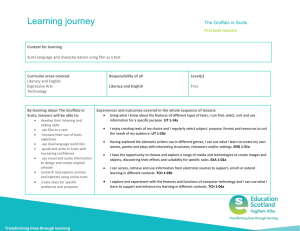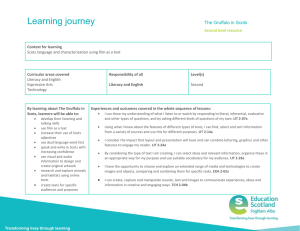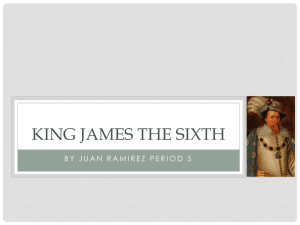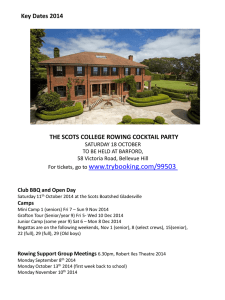Learning journey The Gruffalo in Scots
advertisement
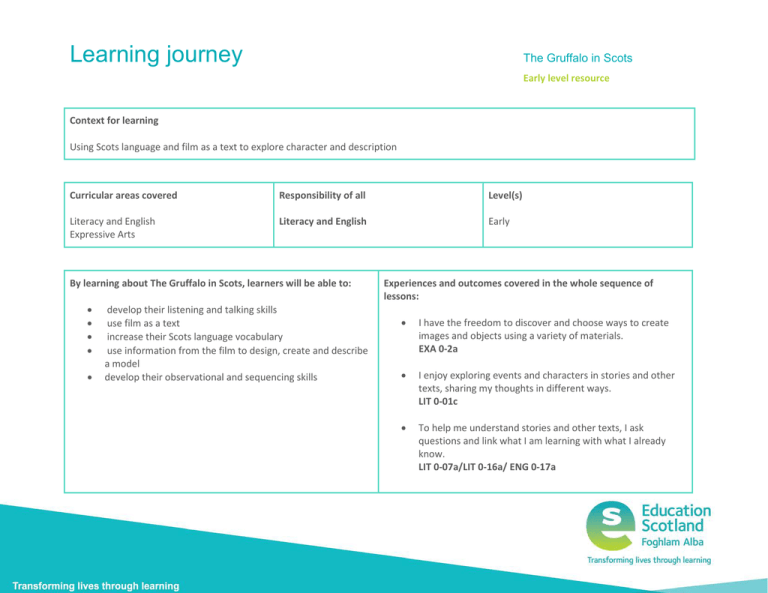
Learning journey The Gruffalo in Scots Early level resource Context for learning Using Scots language and film as a text to explore character and description Curricular areas covered Responsibility of all Level(s) Literacy and English Expressive Arts Literacy and English Early By learning about The Gruffalo in Scots, learners will be able to: • • • • • develop their listening and talking skills use film as a text increase their Scots language vocabulary use information from the film to design, create and describe a model develop their observational and sequencing skills Experiences and outcomes covered in the whole sequence of lessons: • I have the freedom to discover and choose ways to create images and objects using a variety of materials. EXA 0-2a • I enjoy exploring events and characters in stories and other texts, sharing my thoughts in different ways. LIT 0-01c • To help me understand stories and other texts, I ask questions and link what I am learning with what I already know. LIT 0-07a/LIT 0-16a/ ENG 0-17a Learning journey The Gruffalo in Scots Early level resource Lesson 1 Heroes and Villains Lesson 2 Describe and Sequence Lesson 3 Characters and Adjectives Before mentioning the film, discuss heroes and villains with the class. Make a list of films and books that feature heroes and villains. Ask the learners to identify the main characteristics of heroes and villains and record on the board. After watching the film: Either as a class or in groups make a junk model or a large collage picture of the Gruffalo. After watching the film: The hero of this film is the moose. Why do you think the moose is the hero? Would you expect the moose to be the hero? What is the opposite of a hero? Who is the villain in this film? Is there more than one? Choose your favourite character from the film. Draw a picture and underneath it write 3 sentences about this character: 1. My favourite character from the film is _________. 2. This character is a hero/villain. 3. I like this character because _____. Use the Gruffalo Scots descriptive flashcards. In groups, give each learner a different flashcard to illustrate. You may need to discuss the Scots language descriptions with the class. Once completed, ask each group to sequence their flashcards. Use a copy of the Gruffalo in Scots book to check the correct sequence. Ask each group to select their favourite Scots word from the flashcards and explain their choice. Learners can then label the picture/model with Scots adjectives from the Gruffalo Scots Word list. Learners can present their work to the rest of the class explaining what the English equivalents are to the Scots adjectives chosen. Learning journey The Gruffalo in Scots Early level resource Lesson 1: experiences and outcomes covered LIT 0-01a LIT 0-07a LIT 0-16a ENG 0-17a Lesson 1: resources Lesson 1: reflection/product if applicable Link to Gruffalo film clips: https://m.youtube.com/watch?v=yHoyg_pwT2w Group/class discussion Pictures and sentences Lesson 1: ideas for further development This could form the basis of a drama lesson looking at movement associated with heroes and villains. Learning journey The Gruffalo in Scots Early level resource Lesson 2: experiences and outcomes covered EXA 0-2a LIT 0-07a LIT 0-16a ENG 0-17a Lesson 2: resources Lesson 2 : reflection/product if applicable Gruffalo Scots Descriptive Flashcards Link to Gruffalo film clips: https://m.youtube.com/watch?v=yHoyg_pwT2w Class/group discussions Sequencing activity Completed flash cards Lesson 2: ideas for further development Learners could create alternative descriptive flashcards for the moose. Learners could identify and explore the rhyming words in both English and Scots. Learning journey The Gruffalo in Scots Early level resource Lesson 3: experiences and outcomes covered EXA 0-2a LIT 0-01c Lesson 3: resources Lesson 3 : reflection/product if applicable A selection of junk for modelling or collage materials will be required Gruffalo Scots word list Observation of group work Completed models/pictures Presentations to class Lesson 3: ideas for further development Children could repeat this exercise for the moose and compare/discuss their Scots language selections.



